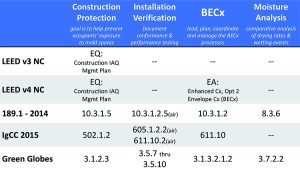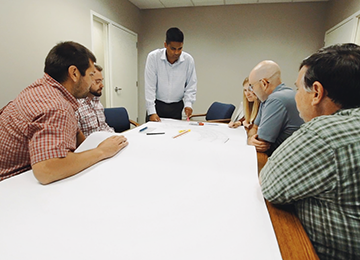There are many codes and standards that guide the design and construction process for buildings. These programs have been adopted by organizations, municipalities and government agencies as recognized standards to achieve green buildings. Unfortunately, some energy efficient designs, while code compliant, may adversely impact durability. In addition, many “green” standards lack sufficient measures to ensure long-term durability of wall assemblies. Across the voluntary green building certifications of LEED v3, LEED v4, 189.1, IgCC, and Green Globes, the items below are related to moisture and durability: Construction Protection, Installation Verification, Building Enclosure Commissioning (BECx), and Moisture Analysis modeling. The chart below summarizes a comparison of the different programs:

Green building programs generally have provisions for a moisture control plan to protect stored on-site and installed absorptive materials from moisture damage. The underlying goal of the construction moisture protection is to help prevent occupants’ exposure to mold spores after construction is completed. Installation Verification captures quality assurance programs that verify conformance with the design contract documents and functional performance testing of moisture managements systems during construction. Moisture Analysis modeling in building envelopes, utilizing ASHRAE Standard 160 is a critical tool for both the design phase of a project or when comparing value engineering options later in the construction document phases. As a tool, moisture analysis performed with software like WUFI can provide valuable information in comparative enclosure assembly scenarios, but is limited in describing a single wall as “good” or “bad”. In a comparison analysis WUFI can show the comparative impact of drying rates and long-term moisture accumulation impacts on an assembly with a selected incidental moisture intrusion rate.
It’s important for a project team to be clear about their goals when utilizing a voluntary green building certification. The green standards reviewed have a lot in common, but many of the details and scope were not comprehensive or consistent. Regardless of the green standard being utilized on a project, it is important to engage a BECx professional with an ANSI-Accredited Personnel Certification Program, like a BCxP, CCP or CxA certification to help guide the process and provide design reviews, construction installation reviews, testing of critical enclosure components, and moisture analysis modeling when it’s needed to compare alternatives.
Read Part II of Moisture and Durability in Voluntary Green Building Certifications here.
Contact us for more information.

